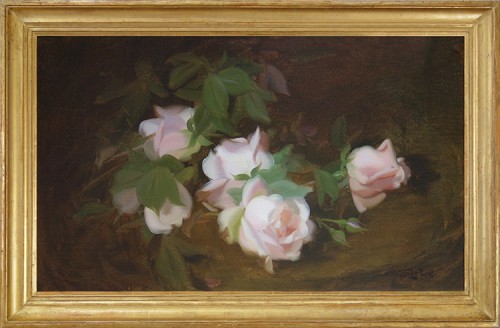An ethereal evocation of roses straight from the garden, this romantic flowerpiece illustrates all Stuart Park’s greatest strengths: the botanical accuracy of form and colour, conjured in single masterly brushstrokes; the observation of light diffused through the translucent petals; the sensation of dewy evanescence created by the casual tumble of flowers on a surface that is barely described. This particular composition has almost the force of a Dutch flowerpiece, a memento mori which uses the subtlety of the roses’ perfection against the earthy ground to conjure their transience. They shine with a ghostly clarity from the shadows where they lie, beautifully and poignantly alive.
Biographical details
James Stuart Park’s parents came from Ayrshire villages, south of Kilmarnock in western Scotland, but he was born in 1862 in Kidderminster, near Birmingham, where his father, a designer, had gone to capitalize on the booming carpet industry. The family moved back to Kilmarnock shortly after, to take advantage of the growing reputation of the local carpet industry. Stuart Park trained part-time at Glasgow School of Art, and then in Paris, at the Académie Julian with Gustave Boulanger and Jules-Joseph Lefebvre, and at the Ecole des Beaux-Arts, with Ferrnand Cormon.
He started out as a portraitist, but finding it difficult to support himself he turned to flowerpieces. His radically simplified style, in which the petals and flowerheads are almost abstracted and painted in rapid, cursive strokes, found favour with the Glasgow Boys, and – although he was unique amongst them as almost solely a painter of flowers – he became a member of the group, along with his peers: Joseph Crawhall, E.A. Walton, Harrington Mann, George Pirie, &c (the last two of whom had also trained with Boulanger and Lefebvre). He exhibited with them at the Royal Scottish Academy and the Royal Glasgow Institute, and worked from a studio in Glasgow until 1896, when he moved back to his home region of Kilmarnock.
The Glasgow Boys were profoundly influenced by the work of Bastien-Lepage: its naturalism, light key, and figures placed in a shallow foreground, which led them to Japanese prints with their similar use of space, and to the equally influential work of Whistler. The same interests can be seen in Stuart Park’s portraits (his Self-portrait, A gipsy maid, c.1890-95, and Dr John MacIntyre, c.1904), and in his earlier flowerpieces, which are notable for their observation, their use of flat tones, shallow space or asymmetric compositions. His best work was produced in the 1880s and -90s, but even his more formulaic later work, with its undifferentiated flowers floating on a black ground, remained extremely popular with his clients. He was an accomplished watercolourist.
Works in public collections include: Begonias, Green & yellow roses, Roses, The Hunterian Museum & Art Gallery, Glasgow; Self-portrait, Woman & roses, Red & white roses, Red & white geraniums, The Dick Institute, Kilmarnock; Orchids, Pansies, Daffodils, Dr John MacIntyre, Glasgow Museums Resource Centre.


